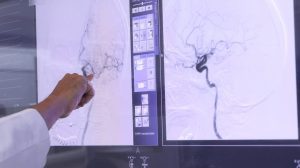NEW YORK (Reuters Health) – When it comes to low back pain, more testing does not mean better care. On the contrary, it may lead to worse care, not to mention higher costs,
That’s the message of a report released online today from the Clinical Guidelines Committee of the American College of Physicians (ACP).
The paper, which appears in the February 1 issue of Annals of Internal Medicine, is the first in the ACP’s new “Advice for High-Value Health Care” series.
There is “good evidence” that routine spinal imaging for low back pain patients is not associated with clinically meaningful benefits but can lead to harms, the Committee states.
It further states that diagnostic imaging with lumbar radiography, computed tomography (CT) or magnetic resonance imaging (MRI) is indicated for patients with low back pain “only if they have severe progressive neurologic deficits or signs or symptoms that suggest a serious or specific underlying condition.”
Decisions for repeat imaging, they advise, should be based on the development of new symptoms or changes in current symptoms.
Diagnostic imaging for low-back pain remains overused, which is a major factor in the “high and growing” costs associated with low back pain, the Committee writes.
“Imaging is an important driver of low back pain costs, not only because of the direct costs of the procedures, but also the downstream effects, such as additional tests, follow-up, and referrals and an invasive procedure of “limited or questionable benefit,” the Committee states.
“Honestly, it’s not just the cost – we are doing real harms to our patients,” Dr. Amir Qaseem, Senior Medical Associate, Department of Clinical Programs and Quality of Care at ACP noted in a telephone interview with Reuters Health. “With unnecessary imaging, patients are not getting good quality care.”
Efforts to reduce unnecessary spinal imaging must address physician behavior and patient expectations, the Committee notes.
“Physicians need to stop order these tests and talk to their patients about why they aren’t ordering a test. Most patients don’t want tests that are not beneficial and may be potentially harmful,” Dr. Qaseem said. “And studies do not support the common perception of a psychological benefit to more testing.”
Curbing financial incentives to diagnostic imaging must also be addressed. “Once you have a CT scanner, you want to use it,” Dr. Qaseem commented. “Defensive medicine also plays a major role, the worry that I will miss something, but fear of lawyers doesn’t mean that you stop providing good care to the patient.”
ACP’s recommendations on selective low back pain imaging are based on a systematic review conducted for the 2007 Diagnosis and Treatment of Low Back Pain joint ACP/APS (American Pain Society) clinical practice guideline and a subsequent meta-analysis.
In a companion paper, “High-Value, Cost-Conscious Health Care: Concepts for Clinicians to Evaluate the Benefits, Harms, and Costs of Medical Interventions,” also published in the February 1 issue of Annals, ACP explains the purpose of its Advice for High-Value Health Care series: to slow the unsustainable rate of health care costs while preserving high-value, high-quality care.
Dr. Qaseem told Reuters Health other “hot topics” upcoming in the ACP’s “Advice for High-Value Health Care” series include neuroimaging in headache, syncope and use of generic versus nongeneric drugs.
“We have a whole list of topics, 30 or 40, that are commonly overused or misused and we are hoping to get at least four or five more papers out in the next year,” Dr. Qaseem said.
In a statement, Dr. Paul Shekelle, chair of ACP’s Clinical Guidelines Committee, said: “The best way to maintain effective and efficient care is to identify and eliminate wasteful practices, and to demonstrate which interventions provide high-value, which means their benefit is sufficient to justify their harms and costs.”
In a related commentary, Drs. Michael Gusmano and Daniel Callahan from The Hastings Center in Garrison, New York say, “Preserving ‘high-value, high-quality care’ while slowing the rate of cost increases will be a highwire act in the face of a steady stream of new and improved technologies, most of which may increase costs.”
Annals of Internal Medicine. Published online January 31, 2011.




